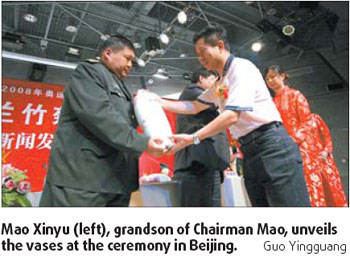Orchids, bamboo, plum, and chrysanthemums are described as gentlemen with noble and unsullied characters in traditional Chinese literature. As subjects of artworks, they are also held in high esteem among Chinese. In fact, late Chairman Mao Zedong's favorite of the four floral spirits is not only found in his many poems but also on the utensils he used, including the porcelain products made exclusively for him, known as Mao Ci or "Chairman Mao porcelain."
On Saturday, a set of four porcelain vases featuring the four plants and reproduced from Mao Ci, were unveiled at the Capital Museum as new Olympic licensed products. The ceremony was held 300 days prior to the 2008 Olympic Games and it was observed by Mao Xinyu, grandson of Chairman Mao.
"It is my great honor to unveil the four vases. Mao Ci was born in Hunan Province which is my grandfather's hometown. Today, I am happy the traditional craftsmanship which accompanied my grandfather for years, can be re-developed for the 2008 Olympic Games," Mao said.
Technically speaking, Mao Ci is a kind of renaissance in Chinese ceramic-making history, marking many breakthroughs in the field.
"I hope Mao Ci can be seen by more people around the world which would help deepen the understanding of China's splendid porcelain making history," says Mao Xinyu, the son of Mao Anqing, second son of Mao Zedong.
Mao Ci was first produced in 1975 and was also known as "7501" ceremic product. To produce high quality porcelain items, experts in Hunan and Jiangxi provinces engaged in intense research for years and created the so-called Red Guan Yao (red government official kiln). Their success came in late 1975. The set of white porcelain pieces produced at that time were painted in light red patterns, such as plum blossom, which were Chairman Mao's favorite flower.
All the products made in 1975 were sent to Beijing. Some items of inferior quality were given as souvenirs to those who had worked to make them. Later, these articles began to appear in the market. At auction, most of the "7501" pieces have been sold for high prices. A single cup could fetch 600,000 yuan ($80,000).
They were made by technicians in two places so it is difficult to replicate such products after so many years.
A set of four porcelain vases are painted with old famous Chinese poems and sayings alongside the four kinds of plants, together with Fuwa, the mascots of the Beijing Olympic Games. (File photos)
To revive the traditional craftsmanship, Deng Wenke and Li Renzhong, two Mao Ci masters who had worked for Chairman Mao in ceramic making, were invited to design and make the four vases. The techniques used now are exactly the same as that used on porcelain products made for Chairman Mao.
The painting of the four kinds of plants also has special meanings. Plum Blossom, the hardy winter flower and the first to come into bloom, year after year, symbolizes constancy in love. Orchid, the fragrant wild orchid that grows near water deep in the woodland is the epitome of femininity and serene beauty in the shadows of obscurity. Chrysanthemum, the emblem of China that goes on flowering in a blaze of color long after summer flowers have faded, defying the onset of winter. Its strong bright blooms are seen as a triumph of hope over adversity. Bamboo, sturdy, upright and vigorous, but with humility, represents a virtuous life.
Moreover, the four vases are painted with old famous Chinese poems and sayings alongside the four plants, together with Fuwa, the mascots of the Beijing Olympic Games, on the top.
"The four vases combine the creative design and high-quality ceramic making skills," says Fu Weijie, the secretary-in-general of China Ceramic Industry Association. "It is the first time in Chinese history we produced such a set of ceramic vases which resemble the ceramics made and used by Chairman Mao in 1975."
A total of 8,000 sets of the four ceramic vases are available for sale.
Chinese traditional porcelain originated in the Shang Dynasty (1600-1046 BC). It became an industry in the Han Dynasty (202 BC- AD 406) and boomed in the Tang (AD 618-907) and Song (960-1279) dynasties. It hit a peak in the Qing Dynasty (1644-1911).
Historically, Chinese porcelain, whose features are said to be "white as jade, thin as paper, bright as a mirror with the sound of a music stone," is famous throughout the world.
(China Daily October 16, 2007)



